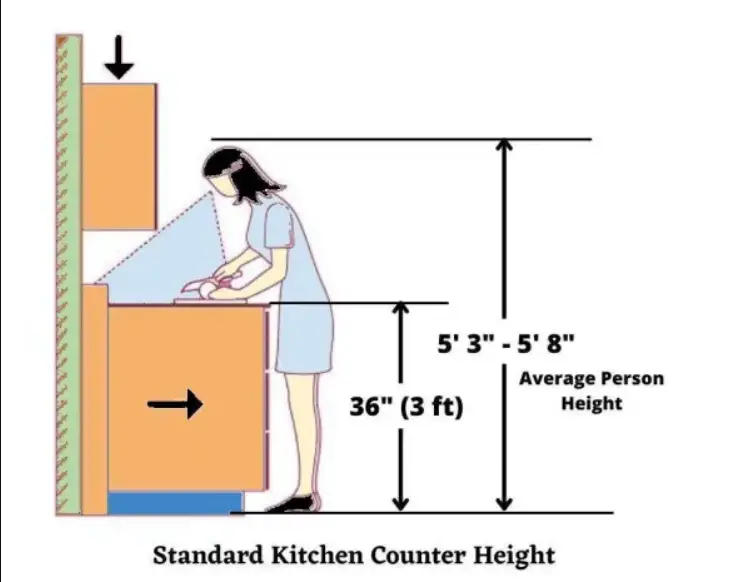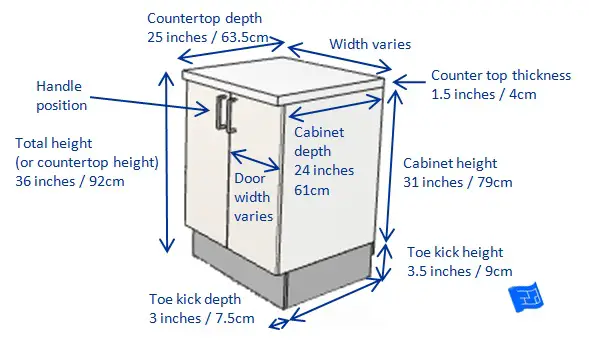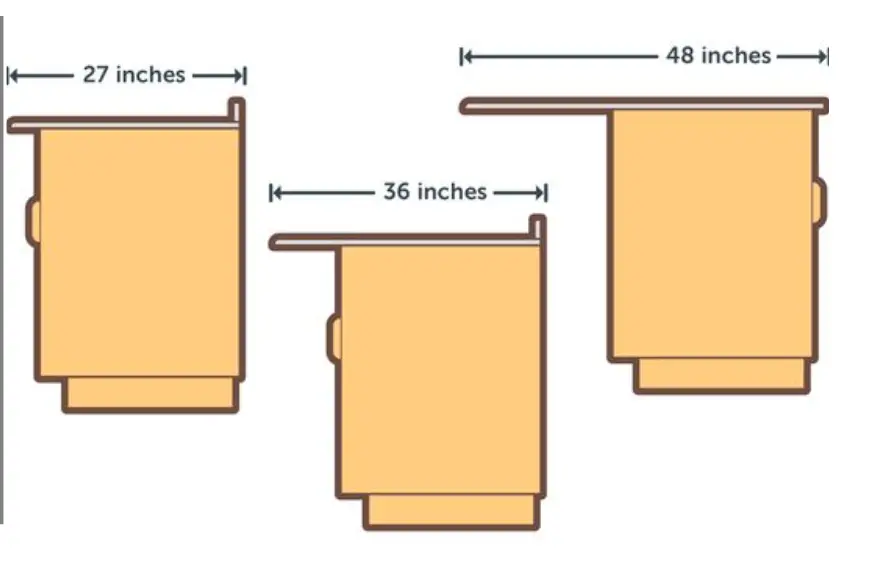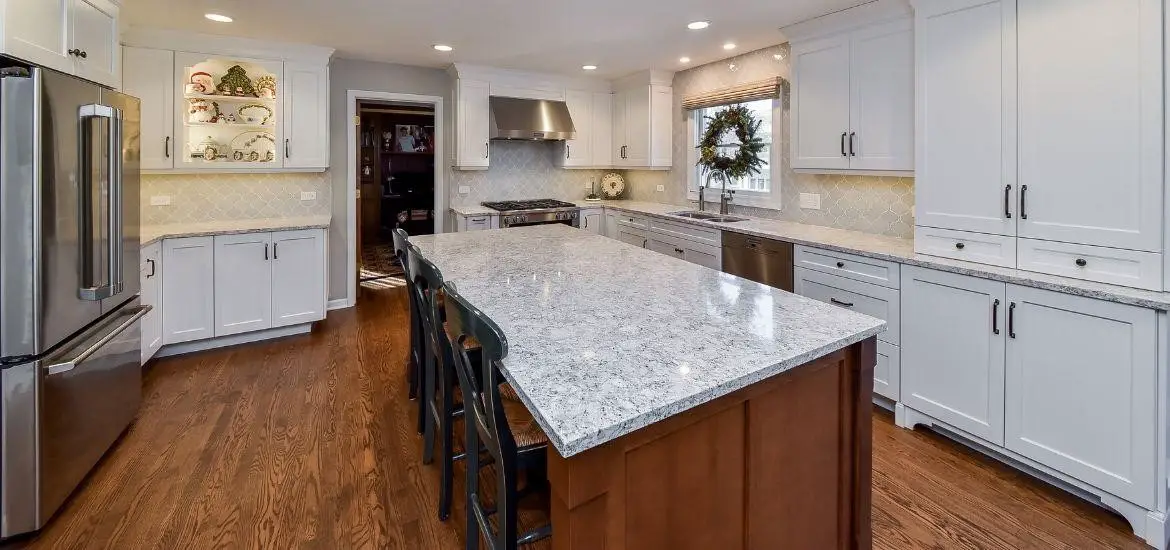When remodeling your kitchen, one of the most important decisions you will make is what width to choose for your countertops. Counters come in a variety of widths, and there is no one perfect size for everyone. The width of countertops can vary depending on your needs and preferences. This article will discuss some of the things you need to think about when deciding on the width of your kitchen countertop, and how to measure and maintain it!
Kitchen Countertop Design for Comfortable Working Space
The kitchen countertop is one of the most important components of your kitchen. It’s where you prepare food, store utensils and appliances, entertain guests, and more. Kitchen countertops come in a variety of widths and materials to accommodate different purposes. Here’s what you need to consider when selecting a countertop for your kitchen.

When deciding how wide your kitchen countertop should be, think about its primary use. Do you need extra room to spread out ingredients while cooking? If so, then wider may be best. You’ll also want to consider the size of the space available — a larger area may require an oversized countertop to maximize workspace efficiency. The type of material used will also play a role in the width. For example, granite countertops are naturally thicker than laminate varieties and won’t require as much space to achieve a sturdy, durable work surface.
No matter what material or size you choose for your kitchen countertop, make sure it is appropriately sized for the purpose you have in mind. A wider countertop may be necessary if you plan on entertaining guests or need extra workspace when cooking meals. On the other hand, a thinner countertop may be best if you’re looking for something easy to maintain and clean. Consider both practicality and aesthetics when selecting a kitchen countertop width, and you’ll be sure to get the perfect one for your home.
Factors That Determine Kitchen Countertop Size
Cabinet Size
The width of the countertop should be determined largely by the size of the cabinets. The standard kitchen cabinet is 23,6 inches deep but can come as shallow as 11,8 inches. A deeper cabinet may require a wider countertop and vice versa.
Kitchen Layout

When planning the layout for your kitchen, think about how much space you need to prepare food and what kind of activities will take place at the counter. For example, if you plan to do most of your cooking on an island or peninsula, it might make sense to go with a wider countertop so you have more workspace. Likewise, if there’s limited space in the kitchen overall, then getting a narrower countertop could help maximize available space while still providing enough room to work.
Cabinet Configuration
The configuration of the cabinets can also play a role in choosing an appropriate countertop width. For instance, if you have two sets of cabinets side-by-side that are different depths, then you may need to opt for a wider countertop so it can span both units.
Appliances
If there are large, freestanding appliances like a range or sink that will be placed next to the countertop, then you may need to adjust the width of the countertop accordingly. For example, if you are placing an oven near the countertop, it makes sense to increase the size of the countertop so there’s enough space for cooking and cleaning around the oven.
Aesthetics
The look and style of your kitchen are also important factors in deciding on a countertop size. If you want your kitchen to have a more streamlined appearance with simple lines and minimal clutter, then opting for a narrow-width countertop might be best. On the other hand, if you prefer a bolder look with plenty of counter space, then a wider countertop is more appropriate.
Countertop Type
Finally, the type of countertop you choose can also help determine how wide it should be. For instance, granite and marble countertops tend to have a minimum width requirement to ensure structural stability. Therefore, if you choose one of these materials for your countertop, then make sure that the specified width is at least as wide as recommended by the manufacturer [1].
Typical Countertop Dimensions
When it comes to how wide a kitchen countertop should be, there is no definitive answer. The width of a kitchen countertop depends on the amount of space you have to work with and the type of countertop material you choose. Standard Kitchen Counters are typically between 23-29,5 inches wide, though these measurements can differ depending on the size and shape of your kitchen or other specific needs.

No matter what type of countertop you choose, it’s important to measure the length and width of your counters before installation to ensure that you’re getting the correct size for your kitchen space. You also want to consider other factors such as sink placement, cabinetry design, and appliance storage when deciding on a suitable countertop width. With this in mind, it’s best to consult a professional for help in determining the ideal size for your kitchen countertop [2].
How To Measure The Size Of A Kitchen Countertop?
When it comes to planning the sizes of your kitchen countertop, there are some key factors to consider. The most important thing is to ensure that you leave enough space for all of your appliances and items that need to be on top. The general rule of thumb is that a standard kitchen countertop should measure at least 23,6 inches deep and 35,4 inches wide.
However, this measurement can vary depending on the size and layout of your kitchen.
When measuring the width of your countertop, make sure to take into account any additional overhang or lip at the edge which could create an obstruction when placing items underneath. It’s also a good idea to measure twice to make sure you have accurate measurements before making cuts on the countertop.
Another important factor to consider is how much weight the countertop will need to bear. If you have a large family or plan on entertaining frequently, it may be necessary to opt for a stronger and more durable material such as granite or quartz. Granite and quartz are great for bearing heavy loads and are available in various sizes so you can find one that fits your kitchen perfectly.
To measure the size of the kitchen countertop, follow these simple steps:
- Measure the length of the countertop from left to right with a tape measure.
- Measure the depth or thickness of the countertop from front to back with a tape measure.
- Add together both measurements and subtract any overhang or lip at the edge.
- Multiply this measurement by two to get your total width in inches.
By measuring your kitchen countertop carefully, you can ensure that you have enough space for everything you need while also selecting a material suitable for your lifestyle and budget.
Countertop Length and Thickness
When it comes to kitchen countertops, size matters. It’s important to consider the length of your countertop so that you have sufficient workspace and storage options in your kitchen. The ideal width for a standard kitchen countertop is 23,6 inches on each side; however, the actual width will depend on how much room you have available.
Customizing Your Countertop for Function and Style
When it comes to the look of your kitchen, there’s no one-size-fits-all approach to countertops. Depending on your style and personal preference, you may choose to have a longer countertop to accommodate more appliances or opt for a shorter length that complements the overall design of your kitchen.
You may also decide to customize your countertop with additional features such as an overhang or breakfast bar. In general, most kitchens benefit from having at least enough space for two people to work comfortably side-by-side while preparing meals. This means that you should aim for at least 39 inches of clear workspace on each side, so your countertop should be a minimum of 78 inches wide.
For larger households or those who entertain regularly, you may want to consider more space for food preparation. A good rule of thumb is to add at least 4 inches of extra width for every additional person in the kitchen. When considering how wide your kitchen countertop should be, think about the different tasks that will take place on it and how much room each task requires to complete comfortably. The style and look of your countertop are important factors as well, so make sure to choose one that suits both your functional and aesthetic needs.
How Does Kitchen Countertop Sizes Differ From Other Countertops?
Bathroom Countertop
When selecting countertop sizes for a kitchen, it is important to consider how they differ from other types of countertops. Bathroom countertops are generally much smaller than those in kitchens, with the most common size being 30 inches wide and 21,65 inches deep. This size allows the user to have enough space to place items they may need while using the bathroom. However, because this size is relatively small compared to a kitchen countertop, there is limited space for food preparation or meal assembly.
Island Countertop
Island countertops are a popular option for larger kitchens, as they provide additional counter space while also offering a unique and trendy look. Island countertops typically range from between 23,6 to 47 inches wide, with depths ranging from between 15,7 to 19,6 inches. This provides enough room for meal assembly and food preparation, and can even offer an area to eat or entertain guests.

Bar Countertop
Bar countertops are a great choice for kitchens that have limited space, but still need to provide additional seating and countertop surface area. Bar countertops are much narrower than regular kitchen countertops, typically having a width of between 9,8 and 15,7 inches. The depth of bar countertops can range from 11,8 to 19,6 inches, making them suitable for both food prep and dining.
How should you maintain the kitchen countertop?
Maintaining a kitchen countertop is an important part of keeping it looking good and lasting for years to come. To ensure your countertop looks its best, there are a few steps you can take:
- Regularly clean the countertop with mild soap and warm water or with a product specifically designed for cleaning stone surfaces. Wipe up spills immediately and avoid using abrasive cleaners that could scratch the surface.
- Use coasters and trivets for hot dishes before placing them on the countertop to protect it from heat damage or staining.
- Polish the surface of the countertop regularly to keep it looking new and polished, but don’t do this more than once a month.
- Seal the countertop every one to two years to ensure it remains protected from water and staining damage [3].
How Wide Is a Kitchen Countertop: Standard Dimensions
The width of a kitchen countertop can vary depending on the design and layout of your kitchen. To provide you with an overview of standard dimensions, we’ve created a table with multiple columns detailing the typical widths of kitchen countertops for various applications.
| Countertop Type | Standard Width | Notes |
|---|---|---|
| Base Cabinets | 24 inches (61 cm) | Common width for standard base cabinets. |
| Island Countertops | 36 inches (91 cm) or wider | Typically wider to accommodate seating or additional workspace. |
| Peninsula Countertops | 24-30 inches (61-76 cm) | Width varies depending on the design and intended use. |
| Bar Tops | 18-24 inches (46-61 cm) | Narrower width suitable for bar seating. |
| Countertop Overhang | 12 inches (30 cm) or more | Overhang beyond cabinets for comfortable seating. |
Explanation of the Table:
- Countertop Type: Specifies different types of kitchen countertops and their standard dimensions.
- Standard Width: Provides the typical width of each countertop type.
- Notes: Offers additional information or considerations related to each countertop type.
These standard dimensions serve as a guideline for planning your kitchen layout and selecting the appropriate countertop width for your needs. Keep in mind that customization is common in kitchen design, so your countertop width can vary based on your preferences and available space.
FAQ
What is standard kitchen counter height?
The standard height for a kitchen countertop is 36 inches. This height is typically measured from the floor to the top of the countertop surface, although some countertops may be slightly taller or shorter depending on preferences and design considerations. The overall width of the kitchen countertop will depend on your space, but 30-36 inches is generally considered optimal.
What should I consider when selecting a kitchen countertop?
When selecting a kitchen countertop, several factors need to be taken into consideration. Firstly, you’ll want to make sure it fits in your available space and that it complements the style of your kitchen. Additionally, you’ll want to consider the material used for the countertop, as some materials are easier to clean and maintain than others. Lastly, you should also think about how much traffic your kitchen countertop is likely to get, as well as its durability to determine which type of material will best suit your needs.
Why Should You Expand Your Current Kitchen Space?
Expanding your kitchen space can have a number of benefits. Firstly, it allows for additional storage space, which is always beneficial in any kitchen. Additionally, an expanded kitchen countertop area gives you more room to work on various activities, such as preparing meals or hosting dinner parties. A larger kitchen also allows for more appliances and accessories to be installed, providing further convenience and functionality. Finally, expanding your kitchen can help increase the value of your home should you decide to sell in the future.
What are standard kitchen counters made of?
Standard kitchen counters are typically made of either granite or laminate. Granite is a popular choice due to its durability and style, while laminate is less expensive and easier to install. Both materials come in a variety of colors and patterns, allowing you to find the perfect fit for your kitchen space.
What is the typical depth of a kitchen countertop?
The standard depth of a kitchen countertop is typically 24 inches (61 centimeters). This depth provides enough space for most kitchen tasks and allows for the installation of standard kitchen appliances and cabinets.
Can I customize the width of my kitchen countertop?
Yes, you can customize the width of your kitchen countertop to suit your specific needs and kitchen layout. While 24 inches is the standard depth, countertop widths can vary based on your design preferences and available space. It’s common to see countertops ranging from 25 to 30 inches in depth.
What should I consider when determining the width of my kitchen countertop?
When deciding on the width of your kitchen countertop, consider factors like the available space in your kitchen, the layout of your cabinets and appliances, and your intended use of the countertop. Ensure that the width allows for comfortable food preparation and fits well within your kitchen’s design.
Are there any standard measurements for countertop overhangs?
Yes, standard countertop overhangs typically extend about 1.5 inches (3.8 centimeters) beyond the front edge of the cabinets. This overhang provides space for comfortable seating if you plan to have a countertop with a bar or island where people can sit.
What are the options for countertop thickness?
Countertop thickness can vary, but the standard thickness for most kitchen countertops is 1.25 to 1.5 inches (3.2 to 3.8 centimeters). However, you can choose thicker countertops for a more substantial and luxurious look if your kitchen design allows for it.
Can I have an irregularly shaped countertop to fit a unique kitchen layout?
Yes, you can have a countertop with irregular or custom shapes to accommodate unique kitchen layouts. Custom countertops can be designed to fit around corners, appliances, or other architectural features to maximize both functionality and aesthetics.
What materials are commonly used for kitchen countertops?
Common countertop materials include granite, quartz, marble, laminate, solid surface, and butcher block. Each material has its own characteristics and price range, so you can choose the one that best suits your design preferences and budget.
Is it necessary to hire a professional for countertop measurement and installation?
While some homeowners may choose to measure and install countertops themselves, it’s often recommended to hire a professional. Professionals can ensure accurate measurements, proper installation, and a finished look that meets your expectations. They can also address any challenges that may arise during the installation process.
Can I install an overhang or extension for a kitchen island countertop?
Yes, you can install an overhang or extension for a kitchen island countertop to create additional seating or workspace. However, it’s important to consult with a professional to ensure the overhang is properly supported and safe for use.
Useful Video: Kitchen Tour: How I Organize the Countertops and Above the Cabinets
Conclusion
Selecting the right kitchen countertop width is an important decision when designing or remodeling your kitchen space. The standard height for a kitchen countertop is 36 inches, but your space and preferences will dictate the overall width. Additionally, you’ll want to consider the material used for your countertop, as well as its traffic level and durability before making a final decision.
Expanding your kitchen can provide additional storage space and convenience, while also increasing the value of your home. Ultimately, with the right measurements and materials in place, you can create an attractive and functional kitchen space that is sure to serve you well for years to come.
References
- https://projectperfecthome.com/average-kitchen-countertop-size/
- https://marble.com/articles/countertop-width
- https://www.architecturaldigest.com/story/how-to-clean-kitchen-countertops














Leave a Reply